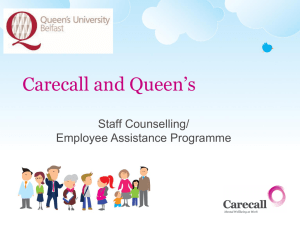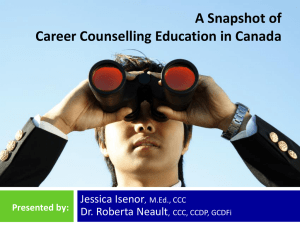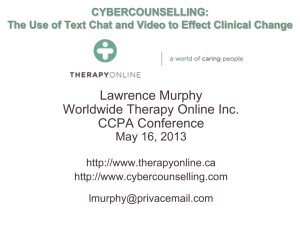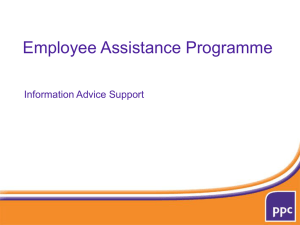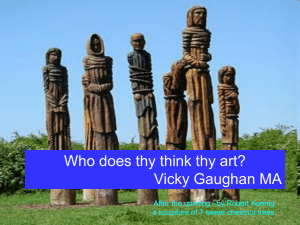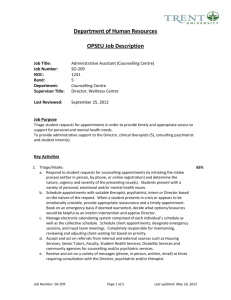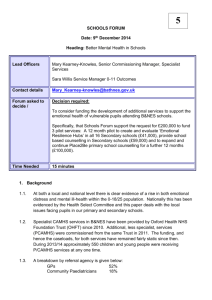Helen Roy Wanted Not Wasted (WOW) C.I.C Providing Counselling
advertisement
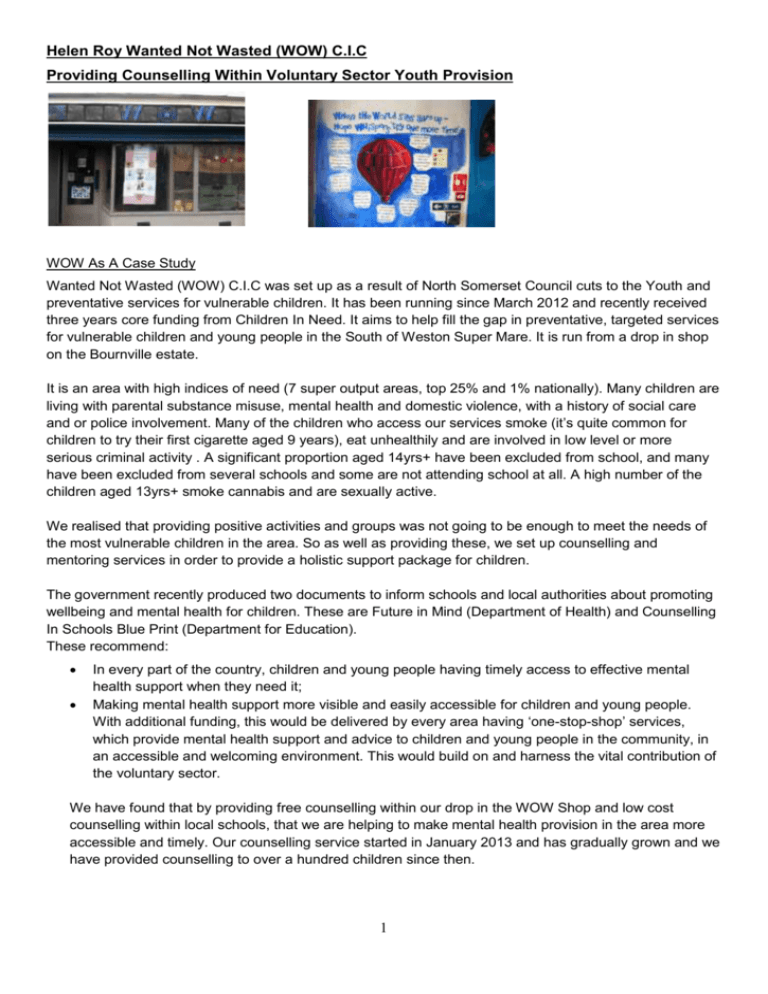
Helen Roy Wanted Not Wasted (WOW) C.I.C Providing Counselling Within Voluntary Sector Youth Provision WOW As A Case Study Wanted Not Wasted (WOW) C.I.C was set up as a result of North Somerset Council cuts to the Youth and preventative services for vulnerable children. It has been running since March 2012 and recently received three years core funding from Children In Need. It aims to help fill the gap in preventative, targeted services for vulnerable children and young people in the South of Weston Super Mare. It is run from a drop in shop on the Bournville estate. It is an area with high indices of need (7 super output areas, top 25% and 1% nationally). Many children are living with parental substance misuse, mental health and domestic violence, with a history of social care and or police involvement. Many of the children who access our services smoke (it’s quite common for children to try their first cigarette aged 9 years), eat unhealthily and are involved in low level or more serious criminal activity . A significant proportion aged 14yrs+ have been excluded from school, and many have been excluded from several schools and some are not attending school at all. A high number of the children aged 13yrs+ smoke cannabis and are sexually active. We realised that providing positive activities and groups was not going to be enough to meet the needs of the most vulnerable children in the area. So as well as providing these, we set up counselling and mentoring services in order to provide a holistic support package for children. The government recently produced two documents to inform schools and local authorities about promoting wellbeing and mental health for children. These are Future in Mind (Department of Health) and Counselling In Schools Blue Print (Department for Education). These recommend: In every part of the country, children and young people having timely access to effective mental health support when they need it; Making mental health support more visible and easily accessible for children and young people. With additional funding, this would be delivered by every area having ‘one-stop-shop’ services, which provide mental health support and advice to children and young people in the community, in an accessible and welcoming environment. This would build on and harness the vital contribution of the voluntary sector. We have found that by providing free counselling within our drop in the WOW Shop and low cost counselling within local schools, that we are helping to make mental health provision in the area more accessible and timely. Our counselling service started in January 2013 and has gradually grown and we have provided counselling to over a hundred children since then. 1 ‘There is evidence of extensive and rising need in key groups, such as the increasing rates of young women with emotional problems and increasing numbers of young people presenting with self-harm. There is also increasing policy acceptance of the long term consequences of ongoing difficulties, including significant impact on employment, physical and mental health, with the oft-quoted figure of 66-75% of adult mental illnesses (excluding dementia) starting by the age of 18’ 1 ‘The last UK epidemiological study suggested that, at that time, less than 25% – 35% of those with a diagnosable mental health condition accessed support. There is emerging evidence of a rising need in key groups such as the increasing rates of young women with emotional problems and young people presenting with self-harm. Data from the NHS benchmarking network and recent audits reveal increases in referrals and waiting times, with providers reporting increased complexity and severity of presenting problems. 3 A recent model developed by the Tavistock Clinic for CAMHS ‘Thrive’, moves away from the Tier model of intervention, and divides children’s mental health needs into four areas: 1. Coping (sign posting, self management, one off contact) 2. Getting help (goal focused, evidence informed and outcome focused intervention) 3. Getting more help(risk management and crisis response) 4. Getting risk support(extensive treatment) The Thrive model suggests that the interventions should not be based upon severity of need or type of problem, but how they are presenting at the time (i.e. coping or not coping). Although this model is based on CAMHS intervention, it is useful to see where voluntary sector counselling fits into this. The level of support we at WOW have been providing, would suggest we fit within the ‘Getting More Help’ and ‘Getting Risk Support’, often in conjunction with other support (social care, school nurse, school support, CAMHS). Although ‘Thrive’ places the burden of supporting children outside of the ‘Coping’ category on statutory health providers, ‘Counselling In Schools A Blue Print’ 2 acknowledges the key role schools and the voluntary sector can play in supporting children with emerging mental health needs. This can include community counsellors assessing children’s mental health needs and supporting schools to decide if further support is needed, reducing the burden of assessment currently placed on CAMHS. Foot Notes 1. THRIVE The AFC–Tavistock Model for CAMHS 2. Counselling In Schools A Blue Print For The Future, Department for Education 3. Future in Mind, Department of Health 2 Thrive Category Presenting issues of child/young person Historical Youth Service Response Areas for future development Resources/Skills Coping (sign posting, self management, one off contact) ‘Within this grouping would be children, young people and families adjusting to life circumstances, with mild or temporary difficulties, where the best intervention is within the community with the possible addition of self-support. This group may also include those with chronic, fluctuating or ongoing severe difficulties, for which they are choosing to manage their own health and/or are on the road to recovery.’ Anxiety, low mood, low self esteem, isolation, loss Activities Mentoring Listening and reflecting Informal education Therapeutic groups Relationship building Web based support Scrap books Getting help (goal focused, evidence informed and outcome focused intervention) ‘This grouping comprises those children, young people and families who would benefit from focused, evidence-based treatment, with clear aims, and criteria for assessing whether aims have been achieved. This grouping would include children and young people with difficulties that fell within the remit of NICE guidance and where there are interventions that might help.’ Getting more help(risk management and crisis response) This grouping comprises those young people and families who would benefit from extensive long-term treatment which may include inpatient care, but may also include extensive outpatient provision. Self harm, suicide ideation, high anxiety, trauma, past abuse, bereavement, persistent low mood, irrational and intrusive thoughts, hearing voices, eating disorders. Trying to support young people within existing services Children at risk of harm: severe self harm, severe eating disorders, suicide attempts, debilitating anxiety, Post Traumatic Stress Disorder, depression. Specialist health involvement. Supporting other Community and agencies and school based parents/carers/siblings counselling Residentials Group work/Workshops 3 Assessment Tools Drop ins Therapeutic games/ sheets School support Stories Leaflets Craft Community and school based counselling Getting risk support(extensive treatment) ‘This grouping comprises those children, young people and families who are currently unable to benefit from evidence-based treatment but remain a significant concern and risk. This group might include children, young people who routinely go into crisis but are not able to make use of help offered, or where help offered has not been able to make a difference, who self-harm or who have emerging personality disorders or ongoing issues that have not yet responded to treatment.’ Children not able to access support. Severe self harm, severe eating disorders, suicide attempts, debilitating anxiety. Complex multiple needs. Social Care involvement. 4 5
